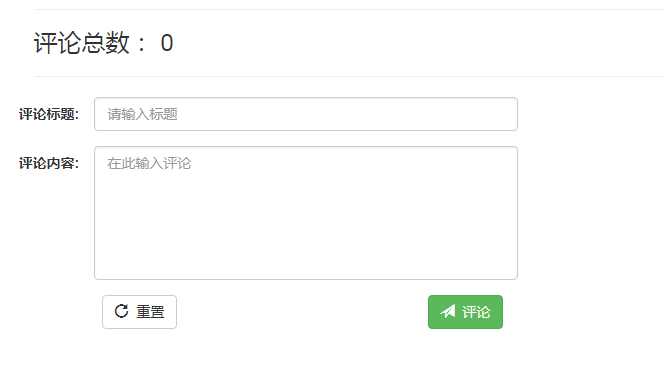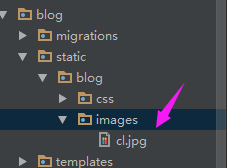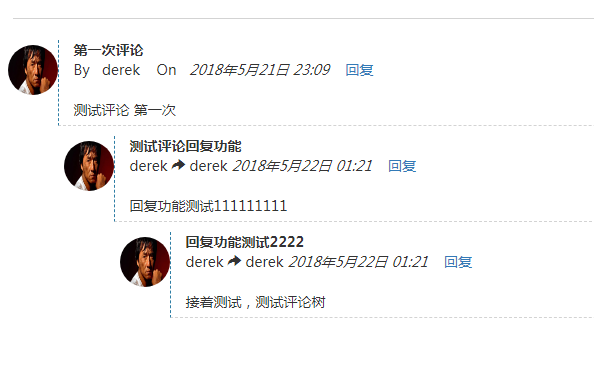6.1.comments插件
(1)安装
pip install django-contrib-comments
(02)settings
INSTALLED_APPS = [ 'django.contrib.sites', 'django_comments', ]
SITE_ID =1

(3)website/url
url(r'^comments/', include('django_comments.urls')),
(4)修改源码
django_comments/abstracts.py第36行
原代码
site = models.ForeignKey(Site, on_delete=models.CASCADE)
修改后
site = models.ForeignKey(Site,default=None,blank=True,null=True,on_delete=models.CASCADE)
(5)修改源码
django_comments/abstracts.py第52行
修改和增加了几个字段
class CommentAbstractModel(BaseCommentAbstractModel): """ A user comment about some object. """ # Who posted this comment? If ``user`` is set then it was an authenticated # user; otherwise at least user_name should have been set and the comment # was posted by a non-authenticated user. user = models.ForeignKey(settings.AUTH_USER_MODEL, verbose_name=_('user'), blank=True, null=True, related_name="%(class)s_comments", on_delete=models.SET_NULL) # Explicit `max_length` to apply both to Django 1.7 and 1.8+. user_email = models.EmailField(_("user's email address"), max_length=254, blank=True,null=True,default='xxx@xxx.com') user_url = models.URLField(_("user's URL"), blank=True,null=True,default='https://xxx.xxx.xxx.xxx') user_name = models.CharField(_("user's name"), max_length=50, blank=True) user_img = models.ImageField(upload_to="user_images", blank=True,null=True,verbose_name="用户图像") comment_title = models.CharField(max_length=256,default="无标题", blank=True,null=True,verbose_name="评论标题") parent_comment = models.ForeignKey('self',default=None, blank=True,null=True,related_name="child_comment",on_delete=models.CASCADE)
level = models.PositiveIntegerField(default=0, blank=True,null=True,verbose_name='评论层级') comment = models.TextField(_('comment'), max_length=COMMENT_MAX_LENGTH)
.
.
.
.
(6)修改源码
django_comments/admin.py第29和37行
_('Content'), {'fields': ('user', 'user_name', 'user_email', 'user_url', 'comment','comment_title','parent_comment')}
list_display = ('comment_title','name', 'content_type', 'object_pk', 'ip_address', 'submit_date', 'is_public', 'is_removed')
(7)修改源码
django_comments/forms.py第97行表单
class CommentDetailsForm(CommentSecurityForm):
"""
Handles the specific details of the comment (name, comment, etc.). """ # name = forms.CharField(label=pgettext_lazy("Person name", "Name"), max_length=50) # email = forms.EmailField(label=_("Email address")) # url = forms.URLField(label=_("URL"), required=False) # Translators: 'Comment' is a noun here. comment = forms.CharField(label=_('Comment'), widget=forms.Textarea, max_length=COMMENT_MAX_LENGTH) comment_title = forms.CharField(max_length=256,label=_('标题')) parent_id = forms.IntegerField(min_value=-1,label=_('父评论的id')) level = forms.IntegerField(min_value=0,label=_('层级'),)
.
.
.
def get_comment_create_data(self, site_id=None): """ Returns the dict of data to be used to create a comment. Subclasses in custom comment apps that override get_comment_model can override this method to add extra fields onto a custom comment model. """ parent_id = self.cleaned_data['parent_id'] if parent_id <= 0: parent = None _level = self.cleaned_data['level'] else: parent = get_model().objects.get(id=parent_id) _level = self.cleaned_data['level'] + 4 # 4是缩进 return dict( content_type=ContentType.objects.get_for_model(self.target_object), object_pk=force_text(self.target_object._get_pk_val()), # user_name=self.cleaned_data["name"], # user_email=self.cleaned_data["email"], # user_url=self.cleaned_data["url"], comment_title = self.cleaned_data['comment_title'], parent_comment = parent, level = _level, comment=self.cleaned_data["comment"], submit_date=timezone.now(), site_id=site_id or getattr(settings, "SITE_ID", None), is_public=True, is_removed=False, )
(8)修改源码
django_comments/views/comments.py第97行表单
52行
# 添加 if not request.session.get('login', None) and not user_is_authenticated: return redirect("/")
116行
# if user_is_authenticated: # comment.user = request.user #添加 if request.session.get('login',None): comment.user_name = request.session['screen_name'] comment.user_img = request.session['profile_image_url']
以上都修改完后
python manage.py makemigtations
python manage.py migrate
6.2.评论表单
detail.html
<div class="row"> <hr /> {% get_comment_form for entry as form %} {% get_comment_count for entry as comment_count %} <h3 >评论总数: {{ comment_count }}</h3> <hr /> </div> <div class="row"> <form class="form-horizontal" action="{% comment_form_target %}" method="post"> {% csrf_token %} <div class="form-group"> <label for="input_title" class="pull-left control-label">评论标题:</label> <div class="col-sm-6"> <input class="form-control" name="comment_title" id="input_title" placeholder="请输入标题" required /> </div> </div> <div class="form-group"> <label for="input_comment" class="pull-left control-label">评论内容:</label> <div class="col-sm-6"> <textarea style="resize:none;" class="form-control" rows=6 name="comment" id="input_comment" placeholder="在此输入评论" required></textarea> </div> </div> <span style="display: none;">{{ form.honeypot }}</span> {{ form.content_type }} {{ form.object_pk }} {{ form.timestamp }} {{ form.security_hash }} <input type="hidden" name="next" value="{% url 'blog:blog_detail' entry.id %}" /> <input name="parent_id" type="hidden" value="-1" /> <input name="level" type="hidden" value="0" /> <div class="form-group col-sm-7"> <div class="pull-left" style="margin-left: 68px;"> <button type="reset" class="btn btn-default"><span class="glyphicon glyphicon-repeat"></span> 重置</button> </div> <div class="pull-right" style="margin-right: 12px;"> <button type="submit" class="btn btn-success" id="id_submit"><span class="glyphicon glyphicon-send"></span> 评论</button> </div> </div> </form> </div>
效果:

现在测试评论,可以添加成功,但是还不能显示
6.3.显示评论
(1)views.py
from django_comments.models import Comment def detail(request,blog_id): # entry = models.Entry.objects.get(id=blog_id) entry = get_object_or_404(models.Entry,id=blog_id) md = markdown.Markdown(extensions=[ 'markdown.extensions.extra', 'markdown.extensions.codehilite', 'markdown.extensions.toc', ]) entry.body = md.convert(entry.body) entry.toc = md.toc entry.increase_visiting() comment_list = list() def get_comment_list(comments): for comment in comments: comment_list.append(comment) children = comment.child_comment.all() if len(children) > 0: get_comment_list(children) top_comments = Comment.objects.filter(object_pk=blog_id, parent_comment=None, content_type__app_label='blog').order_by('-submit_date') get_comment_list(top_comments) return render(request, 'blog/detail.html', locals())
(2)detail.html
<div class="row"> <hr /> {% get_comment_form for entry as form %} {% get_comment_count for entry as comment_count %} <h3 >评论总数: {{ comment_count }}</h3> <hr /> </div> {# 评论表单#} {% if request.session.login or request.user.is_authenticated %} <div class="row"> <form class="form-horizontal" action="{% comment_form_target %}" method="post"> {% csrf_token %} <div class="form-group"> <label for="input_title" class="pull-left control-label">评论标题:</label> <div class="col-sm-6"> <input class="form-control" name="comment_title" id="input_title" placeholder="请输入标题" required /> </div> </div> <div class="form-group"> <label for="input_comment" class="pull-left control-label">评论内容:</label> <div class="col-sm-6"> <textarea style="resize:none;" class="form-control" rows=6 name="comment" id="input_comment" placeholder="在此输入评论" required></textarea> </div> </div> <span style="display: none;">{{ form.honeypot }}</span> {{ form.content_type }} {{ form.object_pk }} {{ form.timestamp }} {{ form.security_hash }} <input type="hidden" name="next" value="{% url 'blog:blog_detail' entry.id %}" /> <input name="parent_id" type="hidden" value="-1" /> <input name="level" type="hidden" value="0" /> <div class="form-group col-sm-7"> <div class="pull-left" style="margin-left: 68px;"> <button type="reset" class="btn btn-default"><span class="glyphicon glyphicon-repeat"></span> 重置</button> </div> <div class="pull-right" style="margin-right: 12px;"> <button type="submit" class="btn btn-success" id="id_submit"><span class="glyphicon glyphicon-send"></span> 评论</button> </div> </div> </form> </div> {% else %} <h3>登陆后才可以评论</h3> {% endif %} <hr /> {# 评论显示区#} <div class="row"> {% for comment in comment_list %} <div class="single_comment" style="margin-left: {{ comment.level }}em"> <div> {% if comment.user_img %} <img src="{{ comment.user_img }}" alt="user_image" /> {% else %} <img src="{% static 'blog/images/cl.jpg' %}" /> {% endif %} </div> <div class="col-md-11 comment-content" style="margin-bottom: 10px;"> <strong>{{ comment.comment_title }}</strong> <div> {% if comment.parent_comment %} {{ comment.user_name }}{{ request.user }} <i class="glyphicon glyphicon-share-alt"></i> {{ comment.parent_comment.user_name }}{{ request.user }} {% else %} By {{ comment.user_name }}{{ request.user }} On {% endif %} <em>{{ comment.submit_date }}</em> {% if request.session.login or request.user.is_authenticated %} <a href="#">回复</a> {% endif %} </div> <br /> <p>{{ comment.comment }}</p> </div> </div> {% endfor %} </div> </div>
(3)static/blog/images/cl.jpg
设置默认图片(如果没有登录就显示默认图片,为了测试评论)

(4)blog/blog_comment.css
hr { border-top: 1px solid lightgrey; border-bottom: 1px solid #fff; } .single_comment { margin-bottom: 20px; font-family: "Microsoft Yahei","微软雅黑",Arial,Helvetica,STHeiti,sans-serif,"Apple Color Emoji","Segoe UI Emoji","Segoe UI Symbol"; } .single_comment img { width:50px; height:50px; border-radius:50%; overflow:hidden; float: left; margin-left: 10px; margin-top: 5px; } .single_comment p { margin-bottom: 0; } .comment-content { border-bottom: 1px dashed lightgrey; border-left: 1px dashed #2d7da4; padding-bottom: 5px; }
detail.html引用
{% block css %} <link rel="stylesheet" href="{% static 'blog/css/github.css' %}"> <link rel="stylesheet" href="{% static 'blog/css/blog_comment.css' %}"> {% endblock %}
效果:

6.4.评论回复
(1)blog/urls.py
url(r'^reply/(?P<comment_id>d+)/$', views.reply, name='comment_reply'),
(2)views.py
from django_comments import models as comment_models def reply(request, comment_id): if not request.session.get('login', None) and not request.user.is_authenticated(): return redirect('/') parent_comment = get_object_or_404(comment_models.Comment, id=comment_id) return render(request, 'blog/reply.html', locals())
(3)blog/reply.html
{% extends 'blog/base.html' %}
{% load comments %}
{% load static %}
{% block title %}回复评论{% endblock %}
{% block css %}
<link rel="stylesheet" href="{% static 'blog/css/blog_comment.css' %}">
{% endblock %}
{% block content %}
<div class="container-fluid" style="margin: 30px 50px 0 50px;min-height: 450px;">
<div class="row">
<div class="single_comment">
<div>
{% if request.session.login %}
<img src="{{ parent_comment.user_img }}" alt="user_img" />
{% else %}
<img src="{% static 'blog/images/cl.jpg' %}" alt="admin_img" />
{% endif %}
</div>
<div class="col-md-11">
<strong>{{ parent_comment.comment_title }}</strong>
<div class="small">
<strong>{{ parent_comment.username }} {{ request.user }}</strong>
<em>{{ parent_comment.submit_date }}</em>
</div>
<br />
<p>{{ parent_comment.comment }}</p>
</div>
</div>
</div>
<br />
{% if request.session.login or request.user.is_authenticated %}
<div class="row" style="margin-left: 30px;">
<h3>回复 {{ parent_comment.username }}{{ request.user }} 的评论:</h3>
{% get_comment_form for parent_comment.content_object as form %}
<form class="form-horizontal" action="{% comment_form_target %}" method="post">
{% csrf_token %}
<div class="form-group">
<label for="input_title" class="pull-left control-label">评论标题:</label>
<div class="col-sm-6">
<input class="form-control" name="comment_title" id="input_title" placeholder="请输入标题" required />
</div>
</div>
<div class="form-group">
<label for="input_comment" class="pull-left control-label">评论内容:</label>
<div class="col-sm-6">
<textarea style="resize:none;" class="form-control" rows=6 name="comment" id="input_comment" placeholder="在此输入评论" required></textarea>
</div>
</div>
<span style="display: none;">{{ form.honeypot }}</span>
{{ form.content_type }}
{{ form.object_pk }}
{{ form.timestamp }}
{{ form.security_hash }}
<input type="hidden" name="next" value="{% url 'blog:blog_detail' parent_comment.content_object.id %}" />
<input name="parent_id" type="hidden" value="{{ parent_comment.id }}" />
<input name="level" type="hidden" value="{{ parent_comment.level }}" />
<div class="form-group col-sm-7">
<div class="pull-left" style="margin-left: 68px;">
<button type="reset" class="btn btn-default"><span class="glyphicon glyphicon-repeat"></span> 重置</button>
</div>
<div class="pull-right" style="margin-right: 12px;">
<button type="submit" class="btn btn-success" id="id_submit"><span class="glyphicon glyphicon-send"></span> 评论</button>
</div>
</div>
</form>
</div>
{% else %}
<h3>登陆后才可以评论</h3>
{% endif %}
<br />
<div>
<a href="{% url 'blog:blog_detail' parent_comment.content_object.id %}">暂时不评论,返回先前页面!</a>
</div>
</div>
{% endblock %}
(4)detail.html
<a href="{% url 'blog:comment_reply' comment.id %}">回复</a>
测试回复功能如下:

6.5.新浪微博登录
(1)settings
CLIENT_ID = 224188xxx APP_SECRET = '76daf2e9e424xxxx71144154f5xx32xx'
(2)website/urls.py
url(r'^login/$', blog_views.login), url(r'^logout/$', blog_views.logout),
(3)views.py
def login(request): import requests import json from django.conf import settings code = request.GET.get('code', None) if code is None: return redirect('/') access_token_url = 'https://api.weibo.com/oauth2/access_token?client_id=%s&client_secret=%s&grant_type=authorization_code&redirect_uri=http://127.0.0.1:8000/login&code=%s' %(settings.CLIENT_ID, settings.APP_SECRET, code) ret = requests.post(access_token_url) data = ret.text #微博返回的数据是json格式的 data_dict = json.loads(data) #转换成python字典格式 token = data_dict['access_token'] uid = data_dict['uid'] request.session['token'] = token request.session['uid'] = uid request.session['login'] = True user_info_url = 'https://api.weibo.com/2/users/show.json?access_token=%s&uid=%s' % (token, uid) user_info = requests.get(user_info_url) user_info_dict = json.loads(user_info.text) #获取微博用户的信息 request.session['screen_name'] = user_info_dict['screen_name'] request.session['profile_image_url'] = user_info_dict['profile_image_url'] return redirect(request.GET.get('next', '/')) def logout(request): if request.session['login']: del request.session['login'] del request.session['uid'] del request.session['token'] del request.session['screen_name'] del request.session['profile_image_url'] return redirect(request.Get.get('next', '/')) else: return redirect('/')
(4)base.html
<ul class="nav navbar-nav navbar-right"> {% if request.session.login %} <li>{{ request.session.screen_name }}<a href="/logout/?next={{ request.path }}"> <i class="glyphicon glyphicon-log-out"></i>注销</a></li> {% else %} <li> <a href="https://api.weibo.com/oauth2/authorize?client_id=2241881638&response_type=code&redirect_uri=http://127.0.0.1:8000/login/?next={{ request.path }}"> <i class="glyphicon glyphicon-log-in"></i> 登录</a></li> {% endif %} </ul>
6.6.部署
(1)settings
STATIC_ROOT = os.path.join(BASE_DIR,'all_static_files')
(2)uwsgi.ini
[uwsgi] socket =127.0.0.1 :8000 chdir = /home/github_project/Myblog module = Myblog.wsgi master = true processes = 4 vacuum = true virtualenv = /root/.virtualenvs/myblog logto = /tmp/mylog.log
(3)Myblog.conf
# the upstream component nginx needs to connect to upstream django { # server unix:///path/to/your/mysite/mysite.sock; # for a file socket server 127.0.0.1:8000; # for a web port socket (we'll use this first) } # configuration of the server server { # the port your site will be served on listen 80; # the domain name it will serve for server_name 116.85.52.205; # substitute your machine's IP address or FQDN charset utf-8; # max upload size client_max_body_size 75M; # adjust to taste # Django media location /media { alias /home/github_project/Myblog/media; # 指向django的media目录 } location /static { alias /home/github_project/Myblog/all_static_files; # 指向django的static目录 } # Finally, send all non-media requests to the Django server. location / { uwsgi_pass django; include uwsgi_params; # the uwsgi_params file you installed } }